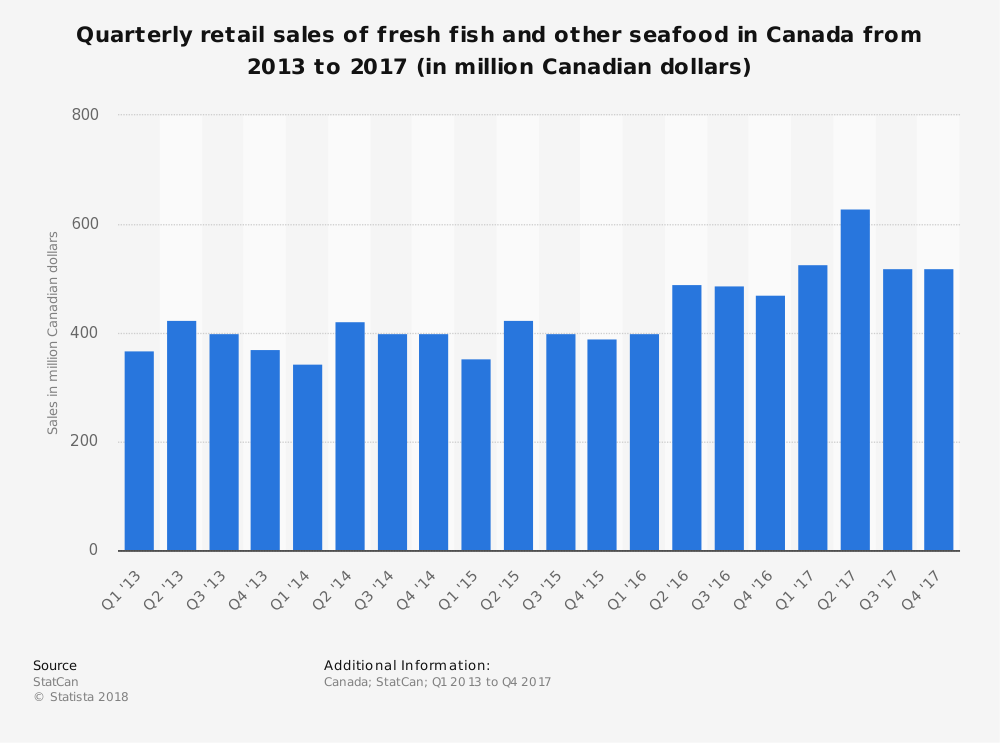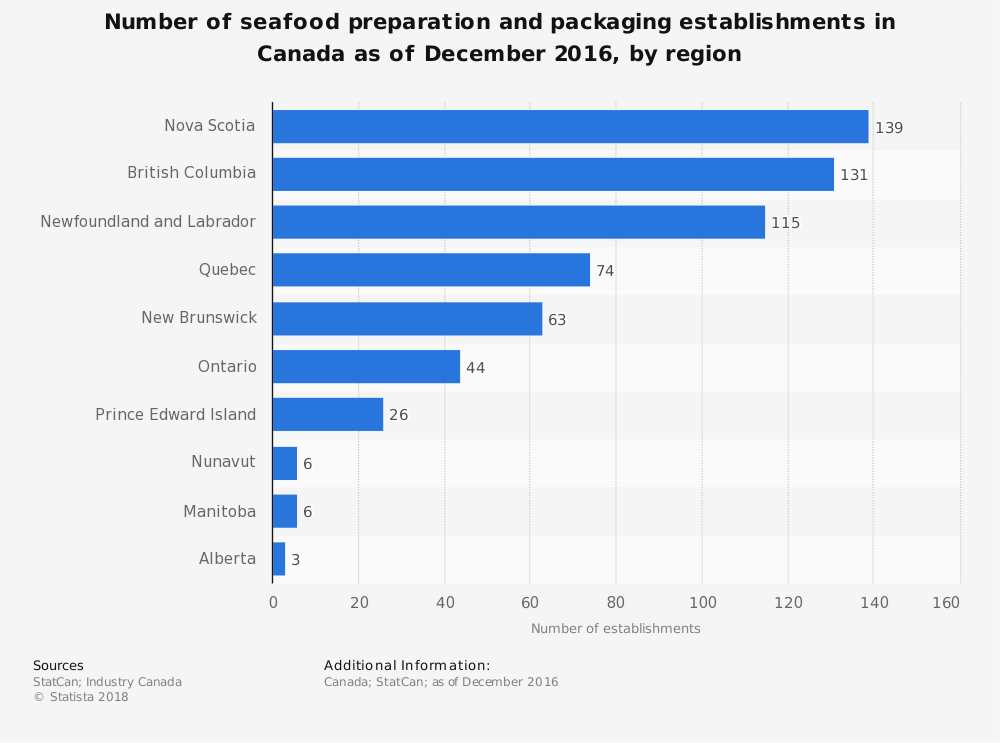Today, the Canadian seafood is one of the most valuable industries in the country. To preserve this value, the industry has instituted a number of management practices, including individual transferable quotas, to keep fisheries healthy. Modern technologies have placed a greater strain on fisheries in recent years, which has caused more than $4 billion in assistance programs to be offered by the Canadian government.
All monetary values stated in these statistics are in Canadian dollars.
Important Canadian Seafood Industry Statistics
#1. In 2016, Canada exported $6.6 billion in fish and seafood products, setting an export value record in doing so. In 2017, Canada set another record, exporting $6.9 billion in products. The Canadian seafood industry is one of the country’s largest export categories for food products. (Fisheries and Oceans: Canada)
#2. Lobster is the top export for the Canadian seafood industry from a value perspective. In 2016, more than $2 billion worth were exported. (Fisheries and Oceans: Canada)

#3. One of the fastest growing industries in the food production category for Canada is aquaculture. More than 45 different species are available for domestic consumption and export through this component of the local seafood industry. (Fisheries and Oceans: Canada)
#4. On its own, the aquaculture industry generates $1 billion in GDP and nearly $3 billion in overall economic activity for Canada. (Fisheries and Oceans: Canada)
#5. About 80,000 people are directly employed by the Canadian seafood industry. (Fisheries and Oceans: Canada)
#6. In 1990, there were 29,000 fishing craft active in the Atlantic Ocean for the Canadian seafood industry. In 2010, there were just 17,200 active fishing craft. (Canadian Council of Professional Fish Harvesters)
#7. As of 2013, British Columbia is responsible for 49% of the total production volume of the industry’s aquaculture segment. They are followed by Prince Edward Island and Newfoundland and Labrador, both of which have 15% of the total production volume each. (Canadian Council of Professional Fish Harvesters)
#8. The farmed-salmon industry in Canada provides more than 10,000 direct employment opportunities on its own. In total, aquaculture provides about 15,000 jobs to Canadians each year. (Fisheries and Oceans: Canada)
#9. In 2016, the Canadian seafood industry provided 7.5kg of fish products per person domestically. That was the lowest level provided since 2010 and is more than 1kg lower than the total products provided in 1988. (Fisheries and Oceans: Canada)
#10. The average Canadian consumes about 23kg of seafood products each year. (Fisheries and Oceans: Canada)

#11. The United States receives about half of all the seafood exports that originate from Canada. In comparison, the average American eats about 7.5kg of seafood each year. (Howard Johnson)
#12. Retailers are responsible for about two-thirds of the sales the Canadian seafood industry experiences each year. Food service businesses, including restaurants, are responsible for the remainder of the sales. (Strategic Information Services)
#13. Over the last 5-year period, the aquaculture industry in Canada has grown at an annualized rate of 6.4%. There are more than 17,000 firms active within the aquaculture segment right now. (IBIS World)
#14. In 2014, Nova Scotia landed more than 51,000 metric tons of lobster. The value of these landings was about $570 million. Within the province, there are more than 160 firms active in the purchase or sale of lobster. (Province of Nova Scotia)
#15. About 60% of the lobster caught in Nova Scotia is exported to the United States, with Europe and Asia having influences on the export market as well. (Province of Nova Scotia)
#16. Nova Scotia also landed 63,000 metric tons of scallops in 2014, with a total value of $162 million. (Province of Nova Scotia)
#17. The Canadian seafood industry exports food products to more than 130 countries. That ranks the industry as the eighth-largest fish and seafood exporter. (Agriculture and Agri-Food: Canada)
#18. The total value of the Pacific commercial landings for the industry totals about $400 million annually. The top species from the Pacific fleet include wild salmon, geoducks, spot prawns, halibut, and Dungeness crab. (Agriculture and Afri-Food: Canada)
#19. Freshwater landings contribute about $60 million in revenues each year as well, with perch, white bass, and pike some of the top species caught. (Agriculture and Agri-Food: Canada)
#20. The total value of frozen lobster exported from Canada was estimated to be over $867 million in 2016. (Statista)

#21. From 2010-2014, the Canadian seafood industry has provided about 1 million metric tons of food products of domestic consumption and export each year. During this same period, the value of landings for the industry increased by 27%. (Islandsbanki)
#22. In 2014, the Canadian seafood industry was the fifth-largest producer of farmed Atlantic salmon. (Islandsbanki)
#23. More than 45,000 commercial fish harvesters work on the waters around Canada’s coasts. (Canadian Council of Professional Fish Harvesters)
#24. Out of the 1 million metric tons of seafood products landed by anglers in Canada, just 31,000 metric tons come from freshwater efforts. (Canadian Council of Professional Fish Harvesters)
#25. The wholesale value of the seafood products caught by the Canadian seafood industry is approximately twice the stated value of the products when initially processed. (Canadian Council of Professional Fish Harvesters)
Canadian Seafood Industry Trends and Analysis
The Canadian seafood industry has recently set records on export values. At the same time, however, domestic demand is much higher than the supply the industry provides. That has created a unique trading balance for the country, as about $3 billion in seafood products are imported each year, despite the industry’s status as one of the largest seafood providers in the world today.
There is no argument about the economic value this industry provides to Canada. It may not compare to other natural resources, such as crude oil, in terms of value. It is the largest industry of its type, however, and it is continuing to grow.
Export demands will only increase for the industry. Americans eat one-third of the seafood products compared to Canadians and their hunger for more seafood is evident. With the U.S. receiving half of all exports, the opportunities to grow will be present for some time to come.
As long as the fisheries are professionally managed, and aquaculture continues expanding, expect the Canadian seafood industry to keep thriving.
Although millions of people visit Brandon's blog each month, his path to success was not easy. Go here to read his incredible story, "From Disabled and $500k in Debt to a Pro Blogger with 5 Million Monthly Visitors." If you want to send Brandon a quick message, then visit his contact page here.
